I think this is the second game I’m going to put into Tier Four (Plankton doesn’t count – it was less of a game than Mountain). Part of this decision is that it was part of a 7-day challenge to make an FPS – and from that perspective it is an interesting exploration of some FPS concepts – but nobody should actually spend money on this.
Receiver is set in a randomly generated level of a post-cyberpunk world. You are tasked with finding eleven tapes and are given a random selection of weapon, flashlight, and/or ammunition. There isn’t too much variety – three weapon types, shared ammo, and only about 15-25 unique “rooms”. That isn’t my complaint – it was made in a week, after all.
The mechanics, compared to traditional FPSs, are tweaked in several unique ways. You must manually reload your gun. Revolvers actually revolve and semi-automatics must be carefully reloaded and checked for jams. The guns have safeties, for some reason. Instead of a stamina bar, you have to quickly tap “w” to run. You die in one hit – even when the enemies don’t. To be accurate: you die very quickly if you are hit multiple times. If you’re only hit once, you die about a second or two later. These, individually, aren’t really my problem either. They’re interesting deviations from the traditional FPS controls and each could make for an interesting added pressure in an otherwise “normal” FPS.
But here’s the thing. Those factors, taken together, make for the worst FPS game feel I have had (I also had strangely sloppy mouse controls, but that may have just been me). Taken together, they require you to be more than perfect: they require you to be lucky. It would be fine if your gun was complicated to draw, fire, and reload as long as you were given some space for mistakes. But with exactly one hit point, all it takes is to walk around the wrong corner to get shot by a turret or chased down by a stun drone before you have time to really do anything about it. An FPS that took such a realistic approach to gunfights and health might also be interesting if your enemies died in one hit as well (though even America’s Army let you get hit two or three times). Tapping “w” to run is a bit silly, and having safeties in a first person shooter game is like playing a face character in a party of murderhobos. As it stands, this game is a testament to all the reasons game developers don’t use the mechanics presented in this game.
The concessions good FPSs have made are there to make the controls less infuriating. A keyboard is not a gun, and a mouse is not your torso. Because of this, a game that has less intuitive controls needs to have some other component to make learning those controls worthwhile – be that story, mechanics, or just a pretty background. I may have a different view than you on this: I firmly hold the opinion that mastering the controls of a game shouldn’t be the real challenge (QWOP is funny, but not actually a good game). A good game has you mastering the mechanics long after you’ve learned the controls. On the Steam page for Receiver, one of the top reviews says that it is the “Dark Souls of FPS” – but the difference between Receiver and Dark Souls is precisely the difference between learning the controls and mastering the mechanics.

